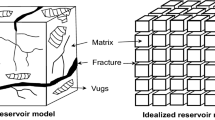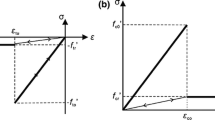Abstract
Core data from the hydraulic fracturing test site 2 (HFTS-2) show that a complex fracture network is created. In this work, a novel fracturing-reservoir simulator is applied to the HFTS-2 data to provide a thorough assessment of the impact of the fracture network on well performance. A methodology is also presented to effectively represent the dynamic propagation of hydraulic fractures in complex naturally fractured formations. First, data that characterize the natural fractures at HFTS-2 are used to create a realistic representation of the reservoir (a discrete fracture network, DFN). Then, a fracturing simulator that fully couples fluid flow, fracture mechanics, and a black oil reservoir simulator is used to first create the fracture network and then simulate flowback and production. A comparison of our simulation results with core data shows good agreement with the characteristics of the natural fracture network based on the post-frac core analysis. The production/flowback results are compared with the field results and are found to agree well with actual production data. While it is possible to use planar fractures to history match production, the results provide unrealistic fracture dimensions and reservoir drainage volumes. This directly impacts design and operational decisions related to well spacing and fracture size, which demonstrates the importance of incorporating realistic complex fracture networks into reservoir simulators for production evaluation and forecasting as well as fracture design and well spacing selection.
Highlights
-
A novel integrated DFN-fracturing-reservoir model is developed that allows us to dynamically model hydraulic fracture propagation in a naturally fractured reservoir followed by multi-phase fluid flowback during production.
-
The model allows us to assess the impact of the natural fracture network on well performance.
-
Natural fractures are represented by a discrete fracture network (DFN), and the interaction of multiple hydraulic fractures with natural fractures is captured by the displacement discontinuity method (DDM).
-
A methodology is presented to automatically calibrate pre-existing natural fractures with core data.

(adapted from Wu et al. 2017)

















Similar content being viewed by others
Data availability
The data that has been used is confidential.
References
Agrawal S, York J, Foster JT, Sharma MM (2020) Coupling meshfree peridynamics with the classical methods for modeling hydraulic fracture growth in heterogeneous reservoirs. Paper presented at the SPE/AAPG/SEG Unconventional Resources Technology Conference, Virtual, July. https://doi.org/10.15530/urtec-2020-3102
Aki K, Richards PG (2002) Quantitative seismology, 2nd edn. University Science Books, Sausalito, California
Baker LE (1988) Three-phase relative permeability correlations. Paper presented at the SPE Enhanced Oil Recovery Symposium, Tulsa, Oklahoma, April. https://doi.org/10.2118/17369-MS
Cao M, Sharma MM (2022a) Factors controlling the flow and connectivity in fracture networks in naturally fractured geothermal formations. SPE Drilling & Completion, pp 1–15
Cao M, Sharma MM (2022b) The impact of changes in natural fracture fluid pressure on the creation of fracture networks. J Petrol Sci Eng 216:110783
Cao M, Sharma MM (2022c) A computationally efficient model for fracture propagation and fluid flow in naturally fractured reservoirs. J Pet Sci Eng 220:111249
Cao M, Hirose H, Sharma MM (2021) Factors controlling the formation of complex fracture networks in naturally fractured geothermal reservoirs. J Pet Sci Eng 208:109642. https://doi.org/10.1016/j.petrol.2021.109642
Choo LQ, Zhao Z, Chen H, Tian Q (2016) Hydraulic fracturing modeling using the discontinuous deformation analysis (DDA) method. Comput Geotech 76:12–22
Ciezobka J (2021) Overview of hydraulic fracturing test site 2 in the Permian Delaware Basin (HFTS-2). Paper presented at the SPE/AAPG/SEG Unconventional Resources Technology Conference, Houston, Texas, USA. https://doi.org/10.15530/urtec-2021-5514
Craig DP, Hoang T, Li H, Magness J, Ginn C, Auzias V (2021) Defining hydraulic fracture geometry using image logs recorded in the laterals of horizontal infill wells. Paper presented at the SPE/AAPG/SEG Unconventional Resources Technology Conference, Houston, Texas, USA, July. https://doi.org/10.15530/urtec-2021-5031
Fu W, Morris JP, Sherman CS, Fu P, Huang J (2022) Controlling hydraulic fracture growth through precise vertical placement of lateral wells: insights from HFTS experiment and numerical validation. Rock Mech Rock Eng 55:5453–5466. https://doi.org/10.1007/s00603-022-02906-8
Gale JFW, Reed RM, Holder J (2007) Natural fractures in the Barnett Shale and their importance for hydraulic fracture treatments. Am Assoc Pet Geol Bull 91:603–622. https://doi.org/10.1306/11010-606061
Gale JFW, Elliott SJ, Rysak BG, Ginn CL, Zhang N, Myers RD, Laubach SE (2021) Fracture description of the HFTS-2 slant core, Delaware Basin, West Texas. Paper presented at the SPE/AAPG/SEG Unconventional Resources Technology Conference, Houston, Texas, USA, July. https://doi.org/10.15530/urtec-2021-5175
Grechka V, Howell B, Li Z, Furtado D, Straus C (2021) Microseismic at HFTS2: a story of three stimulated wells. Paper presented at the SPE/AAPG/SEG Unconventional Resources Technology Conference, Houston, Texas, USA, July. https://doi.org/10.15530/urtec-2021-5517
Gu H, Weng X (2010) Criterion for fractures crossing frictional interfaces at non-orthogonal angles. Presented at 44th U.S. Rock Mechanics Symposium and 5th U.S.-Canada Rock Mechanics Symposium, Salt Lake City, Utah. 27–30 June. ARMA-10-198
Kumar A, Seth P, Shrivastava K, Sharma MM (2018) Optimizing drawdown strategies in wells producing from complex fracture networks. Paper presented at the SPE International Hydraulic Fracturing Technology Conference and Exhibition. Muscat, Oman. https://doi.org/10.2118/191419-18IHFT-MS
Li S, Zhang D, Li X (2017) A new approach to the modeling of hydraulic-fracturing treatments in naturally fractured reservoirs. SPE J 22(1064–1081):04
Lotfollahi SM (2015) Development of a four-phase flow simulator to model hybrid gas/chemical EOR processes (Doctoral dissertation)
Maxwell SC, Mack M, Zhang F, Chorney D, Goodfellow SD, Grob M (2015) Differentiating wet and dry microseismic events induced during hydraulic fracturing. Paper presented at the SPE/AAPG/SEG Unconventional Resources Technology Conference, San Antonio, Texas, USA, July. doi: https://doi.org/10.15530/URTEC-2015-2154344
Miehe C, Mauthe S (2016) Phase field modeling of fracture in multi-physics problems. Part III. Crack driving forces in hydro-poro-elasticity and hydraulic fracturing of fluid-saturated porous media. Comput Methods Appl Mech Eng 304:619–655. https://doi.org/10.1016/j.cma.2015.09.021
Moinfar A (2013) Development of an efficient embedded discrete fracture model for 3D compositional reservoir simulation in fractured reservoirs (doctoral dissertation). http://hdl.handle.net/2152/21393
Nguyen VP, Lian H, Rabczuk T, Bordas S (2017) Modelling hydraulic fractures in porous media using flow cohesive interface elements. Eng Geol 225:68–82
Ouchi H, Katiyar A, Foster J, Sharma MM (2015) A peridynamics model for the propagation of hydraulic fractures in heterogeneous, naturally fractured reservoirs. Presented at SPE Hydraulic Fracturing Technology Conference, The Woodlands, Texas, USA. 3–5 February. SPE-173361-MS. https://doi.org/10.2118/173361-MS
Rabczuk T, Belytschko T (2004) Cracking particles: a simplified meshfree method for arbitrary evolving cracks. Int J Numer Meth Eng 61(13):2316–2343
Raterman KT, Farrell HE, Mora OS, Janssen AL, Gomez GA, Busetti S, McEwen J, Davidson M, Friehauf K, Rutherford J, Reid R, Jin G, Roy B, Warren M (2017) Sampling a stimulated rock volume: An Eagle Ford example. Presented at Unconventional Resources Technology Conference (URTeC), Austin, Texas. 24–26 July. URTeC-2670034-MS. https://doi.org/10.15530/URTEC-2017-2670034
Renshaw CE, Pollard DD (1995) An experimentally verified criterion for propagation across unbounded frictional interfaces in brittle, linear elastic materials. Int J Rock Mech Min Sci Geomech Abstr 32:237–249. https://doi.org/10.1016/0148-9062(94)00037-4
Segall P, David DD (1983) Joint formation in granitic rock of the Sierra Nevada. Geol Soc Am Bull 94(5):563–575
Shang J, Jayasinghe LB, Xiao F, Duan K, Nie W, Zhao Z (2019) Three-dimensional DEM investigation of the fracture behaviour of thermally degraded rocks with consideration of material anisotropy. Theoret Appl Fract Mech 104:102330
Stone HL (1970) Probability model for estimating three-phase relative permeability. J Pet Technol 22:214–218. https://doi.org/10.2118/2116-PA
Sun Y, Yu H (2022) A unified non-local fluid transport model for heterogeneous saturated porous media. Comput Methods Appl Mech Eng 389:114294
Warpinski NR, Teufel LW (1987) Influence of geologic discontinuities on hydraulic fracture propagation (includes associated papers 17011 and 17074). J Pet Technol 39:209–220. https://doi.org/10.2118/13224-PA
Warpinski NR, Mayerhofer MJ, Agarwal K, Du J (2013) Hydraulic fracture geomechanics and microseismic-source mechanisms. SPE J 18(3):766–780
Warpinski NR, Mayerhofer MJ, Davis EJ, Holley EH (2014) Integrating fracture diagnostics for improved microseismic interpretation and stimulation modeling. Presented at the 2014 Unconventional Resources Technology Conference, Denver, Colorado, 25–27 August. https://doi.org/10.15530/urtec-2014-1917906
Wu K, Olson JE (2015) A simplified three-dimensional displacement discontinuity method for multiple fracture simulations. Int J Fract 193:191–204. https://doi.org/10.1007/s10704-015-0023-4
Wu WW, Kakkar P, Zhou JH, Russell R, Sharma MM (2017) An experimental investigation of the conductivity of unpropped fractures in shales. Paper presented at the SPE Hydraulic Fracturing Technology Conference and Exhibition, The Woodlands, Texas, USA, January. https://doi.org/10.2118/184858-MS
Yan X, Yu H (2022) Numerical simulation of hydraulic fracturing with consideration of the pore pressure distribution based on the unified pipe-interface element model. Eng Fract Mech 275:108836
Yan X, Sun Z, Dong Q (2021) The unified pipe-interface element method for simulating the coupled hydro-mechanical grouting process in fractured rock with fracture propagation. Eng Fract Mech 256:107993
Yi S, Wu CH, Sharma MM (2021) Optimization of plug-and-perforate completions for balanced treatment distribution and improved reservoir contact. SPE J 25:558–572. https://doi.org/10.2118/194360-PA
Zhang Y, Zhuang X (2019) Cracking elements method for dynamic brittle fracture. Theoret Appl Fract Mech 102:1–9
Zheng S, Sharma MM (2021) Coupling a geomechanical reservoir and fracturing simulator with a wellbore model for horizontal injection wells. Int J Mult Comp Eng 20(3):23–55. https://doi.org/10.1615/IntJMultCompEng.2021039958
Zheng S, Kumar A, Gala DP, Shrivastava K, Sharma MM (2019) Simulating production from complex fracture networks: impact of geomechanics and closure of propped/unpropped fractures. Paper presented at the Unconventional Resources Technology Conference, Denver, Colorado, USA, July 22–24. https://doi.org/10.15530/urtec-2019-21
Zheng S, Hwang J, Manchanda R, Sharma MM (2021) An integrated model for non-isothermal multi-phase flow, geomechanics and fracture Propagation. J Petrol Sci Eng 179:758–775. https://doi.org/10.1016/j.petrol.2019.04.065
Acknowledgements
The authors would like to acknowledge the funding and support from the member companies of the Hydraulic Fracturing and Sand Control Joint Industry Consortium at the University of Texas at Austin.
Author information
Authors and Affiliations
Corresponding author
Ethics declarations
Conflict of Interest
The authors declare that they have no known competing financial interests or personal relationships that could have appeared to influence the work reported in this paper.
Additional information
Publisher's Note
Springer Nature remains neutral with regard to jurisdictional claims in published maps and institutional affiliations.
Rights and permissions
Springer Nature or its licensor (e.g. a society or other partner) holds exclusive rights to this article under a publishing agreement with the author(s) or other rightsholder(s); author self-archiving of the accepted manuscript version of this article is solely governed by the terms of such publishing agreement and applicable law.
About this article
Cite this article
Cao, M., Zheng, S., Elliott, B. et al. A Novel Integrated DFN-Fracturing-Reservoir Model: A Case Study. Rock Mech Rock Eng 56, 3239–3253 (2023). https://doi.org/10.1007/s00603-023-03231-4
Received:
Accepted:
Published:
Issue Date:
DOI: https://doi.org/10.1007/s00603-023-03231-4




